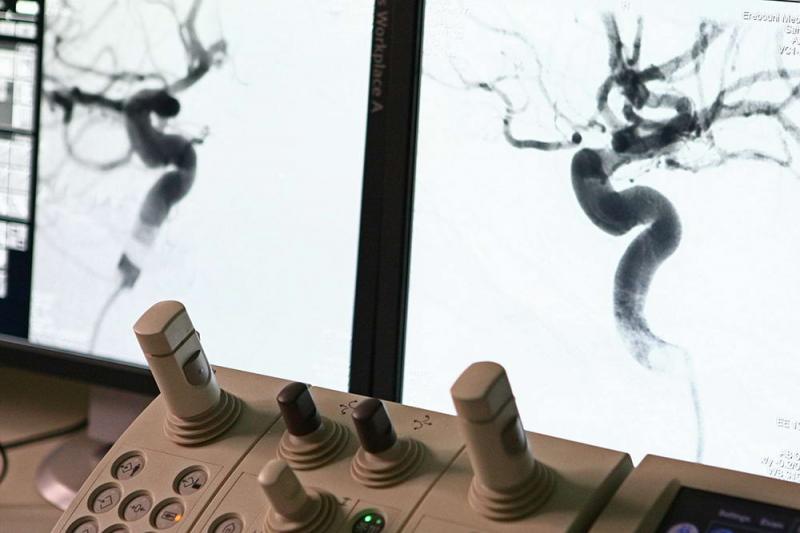In certain types of intracranial aneurysms their endovascular obliteration, with the exclusively use of microspirals is impossible because of the high risks of their prolapse after the placement into the carrying artery with consequent its occlusion. This is especially refers to small wide-necked aneurysms. On this case there is a need for additional methods use for retention of spirals in aneurysm cavity.
A 23-yr-old patient T.M. was admitted to MC “Erebouni” in critical condition with cognitive challenges, psychomotor agitation and uncontrolled hypotension in June 2015. Urgently was carried out the CT angiography and was revealed massive subarachnoid hemorrhage with brain edema. The patient was brought to the operating room immediately for carrying out diagnostic cerebral angiography, which revealed ruptured of the saccular aneurysm of anterior communicating artery. In order to prevent the rerupture, on an urgent basis was performed endovascular obliteration of aneurysm cavity with the use of microspirals.
During examination the patient was diagnosed as small unruptured aneurysms of bifurcation of the internal carotid artery with a wide neck. Its characteristics didn`t allow performing of obliteration without use of intracranial stenting. In the stent implantation the use of antiplatelet therapy is indicated (in order to prevent stent thrombosis). However, in this patient with a ruptured aneurysm and acute hemorrhage the use of antiplatelet therapy was contraindicated. Taking into consideration the fact relatively low risk of rupture of the internal carotid artery bifurcation aneurysm and also the acute period with presence of haemorrage it was made a decision to observe the of internal carotid artery bifurcation aneurysm in the follow-up.
Further treatment of the patient was provided in Department of Intensive Care and Neurology Department of MC “Erebouni”. A week later after hemorrhage patient has a cerebral vasospasm due to affection of subarachnoid hemorrhage on the cerebral vessels. This could lead to irreversible cerebral ischemia. Urgently was carried out endovascular therapy of cerebral vasospasm by injection of a high dose of antispasmodic drug selectively in intracranial arteries.
The patient was discharged in a satisfactory condition with minimal neurologic deficit and within the following 9 months had been under follow-up observation. According to the angiographic examination data it was stable embolisation of the ruptured aneurysm. This method of treatment of cerebral aneurysms, particularly in acute period (at ruptures and hemorrhage) once more have proven to be effective by the significant increase of this pathology treatment results in MC “Erebouni”.
On this stage was made a decision to perform the treatment of unruptured aneurysm of internal carotid artery bifurcation for preventing its further growth and rupture.
In April 2016 stent-assisted endovascular obliteration of intracranial saccular aneurysm was conducted by the head of the Department of Cerebrovascular Neurosurgery Dr. D. Sahakian. In the neck of the aneurysm it was deployed the intracranial stent, which retained implanted spirals in the aneurysm cavity.
Post-operative condition was normal. The patient was discharged on the second day in a satisfactory condition.
This kind of phased and combined surgical intervention was performed in Armenia in MC “Erebouni” for the first time and it is another achievement in development of endovascular neurosurgery in our country.




